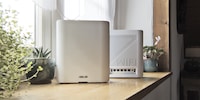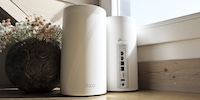

The Asus ZenWiFi AX speed test: how good is a mesh router without a mesh?
It's the polar opposite of a monstrous router, offering Tri-Band as well as Wi-Fi 6 and can easily be expanded to a mesh system with a second model. Time to see how well it performs in test conditions. And what it's potential for a mesh network is.
We already know how much value Wi-Fi 6 aka IEEE 802.11ax can add. Check out what beamforming, OFDMA and MU-MIMO can do right here. The router we're looking at today can do all this and more. The Asus ZenWiFi AX can be expanded into a mesh system and even into a third frequency band. The Tri-Band router automatically distributes data traffic to one 2.4 GHz band and two 5 GHz bands if desired. Splitting the 5 GHz frequency band into two, one serving the lower channels and the other the upper channels, theoretically gives WLAN a higher throughput.
If you want to buy a single ZenWiFi router, you'll need patience. For both colours, delivery periods of several months must be expected at time of writing.
Getting hold of a double pack is a bit easier at the moment, allowing you to set up a mesh system. I'm testing this one too, but only in the next instalment of this series.
Technical data for the ZenWiFi AX (XT8):
- Processor and memory: 1.5 GHz 64-bit dual-core processor, 512 MB of RAM (DDR3).
- Antennas: 6 x internal (two of them at 45 degree angle).
- Ports: 1 x RJ45 WAN (2.5 Gigabit), 3 x RJ45 LAN (Gigabit), 1 x USB 3.1 Type-A.
- 5 GHz network standards: IEEE 802.11ax/ac/n/a
- 2.4 GHz network standards: IEEE 802.11ax/n/b/g
- Transmission rate 2.4 GHz: up to 574 Mbps
- Transmission rate 5 GHz 1: up to 1201 Mbps
- Transmission rate 5 GHz 2: up to 4804 Mbps
- Encryptions: WPA3-PSK, WPA2-PSK, WPA-PSK, WPA-Enterprise , WPA2-Enterprise , WPS support.
- User modes: wireless router, access point.
- Dimensions: 16 x 7.5 x 16.15 cm, 716 g.
- Operation: WPS Button, Reset Button, Power Switch.
- **Features: ** Tri-Band Router, actively cooled, Range Boost, OFDMA, beamforming, MU-MIMO, Guest Network, VPN Server & Client, Firewall, UPnP, Media server, File server and more.
Apartment floor plan and router location
The testing area, my apartment, covers about 140 m² spread over two attics. Major hurdles for the signal are the installed floor heating and reinforced concrete between the floors.
I attach the Asus router to the most central cable connection of the apartment – in the second attic.
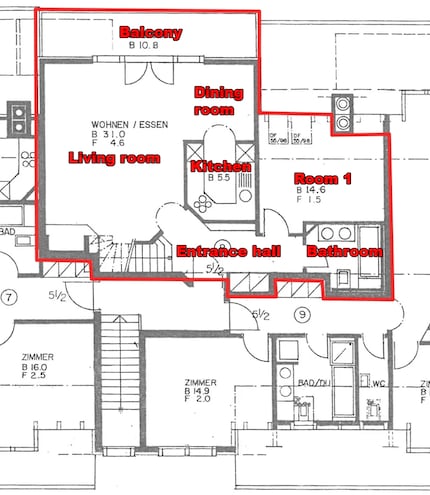
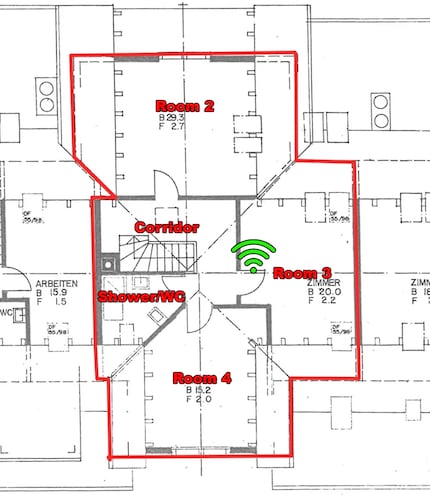
Setting it up
The easiest way to set up the box is via smartphone. Wi-Fi, Bluetooth and location sharing must be enabled on Android or iPhone before the Asus Router App can be booted up. The app is kept simple and self-explanatory during setup. The only thing I'm missing is a choice of operating modes. This can, like many other things, be done afterwards in the settings via the app or web interface of the router.
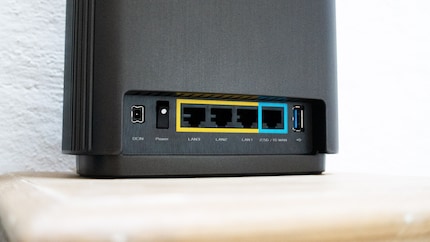
The router offers a total of four RJ45 ports: one 2.5 Gigabit WAN port and three Gigabit LAN ports. A USB 3.1 port type A is also available.
The design of the router is kept simple. All six antennas are installed internally. Two of them are mounted at a 45-degree angle to allow better access to devices above or below the router. It also has active cooling, which I never noticed during testing. Air is drawn through the cooling slits on the side of the unit.
Speed, ping and signal strength per room
With the same AX capable notebook as always, I start to test the speed with my trusty «LAN Speed Test». I determined the latency in the DOS console by checking the response time to my NAS with a ping command. For the signal strength, which is specified in decibel milliwatts (dBm), I used the «NetSpot» software. The heat maps further down were also provided by NetSpot.
Results
The ZenWiFi AX Router performs as follows:
| Location | 5 GHz frequency range speed/ping/signal strength | 2.4 GHz frequency range speed/ping/signal strength |
|---|---|---|
| Entrance hall | 391,82 Mbps / 3 ms / -70 dBm | 144,65 Mbps / 3 ms / -54 dBm |
| Living room | 112,90 Mbps / 4 ms / -84 dBm | 77,29 Mbps / 4 ms / -67 dBm |
| Dining room | 65,74 Mbps / 4 ms / -84 dBm | 83,16 Mbps / 3 ms / -66 dBm |
| Kitchen | 136,13 Mbps / 3 ms / -81 dBm | 132,74 Mbps / 4 ms / -65 dBm |
| Balcony | 0 Mbps / kein Ping / -89 dBm | 25,33 Mbps / 5 ms / -80 dBm |
| Room 1 | 211,47 Mbps / 4 ms / -77 dBm | 118,02 Mbps / 3 ms / -59 dBm |
| Bathroom | 260,83 Mbps / 4 ms / -70 dBm | 130,47 Mbps / 4 ms / -54 dBm |
| Corridor | 705,92 Mbps / 3 ms / -62 dBm | 163,09 Mbps / 3 ms / -57 dBm |
| Room 2 | 470,08 Mbps / 3 ms / -70 dBm | 101,68 Mbps / 3 ms / -58 dBm |
| Room 3 | 828,41 Mbps / 2 ms / -44 dBm | 171,96 Mbps / 2 ms / -41 dBm |
| Room 4 | 593,26 Mbps / 3 ms / -70 dBm | 110,72 Mbps / 3 ms / -60 dBm |
| Shower/Bathroom | 651,75 Mbps / 2 ms / -59 dBm | 127,81 Mbps / 3 ms / -54 dBm |
| Ø | 369,03 Mbps / 3 ms* / -72 dBm | 115,58 Mbps / 3 ms / -60 dBm |
* Average value of rooms that have a signal. The balcony is excluded.
On the top floor the router is unstoppable, delivering an average of 650 Mbps in the 5 GHz range with 3 milliseconds of latency – a new record. Even signal strength is ok. But the high frequencies downstairs don't reach good values. Although the speed is still sufficient to watch a UHD stream in Blu-ray quality in the dining area, good luck doing that on the balcony. Furthermore, the -84 dBm values in the living room and dining area are dangerously low. The only reason the speed doesn't collapse even more is probably due to the fact that my neighbourhood has few competing Wi-Fi networks.
The 2.4 GHz range coverage looks much better. The signal strength is a good -60 dBm, the ping is 3 milliseconds and I can surf with an average of 115.58 Mbps. The balcony still achieves 25.33 Mbps. This allows at least one UHD stream to be viewed in Netflix quality.
5 GHz range heat map
I'm not a fan of the dark blue areas in the heat maps. Above -80 dBm, interference of any kind – whether from a microwave, foreign networks or another wall – can signal death for Wi-Fi. So we're lucky that we even have slow 5 GHz Wi-Fi on the far-right balcony.

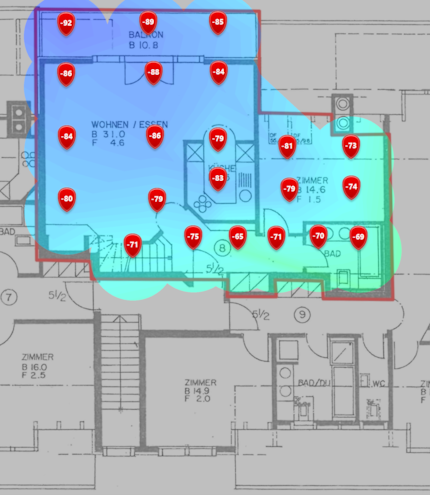
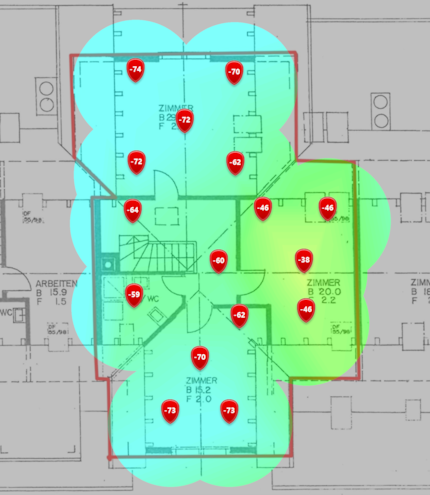
2.4 GHz range heat map
I'm happy with the 2.4 GHz coverage. Especially on the top floor, a much larger area can be covered.

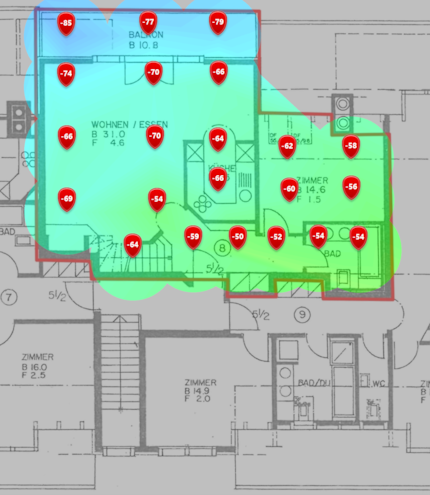
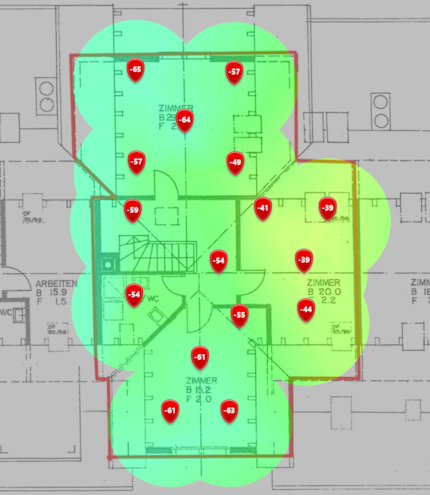
Comparison with the competition
Direct comparisons in the same test area are rare. I'm gonna change that. The single router that has so far performed best in the 5 GHz frequency range in this apartment is the Swisscom Internet Box 3. It's in first place, even if only by a narrow margin in terms of speed. This changes in the 2.4 GHz frequency range – Asus offers a bit more speed and a millisecond better ping here.
The 5 GHz comparison:
| Location | Asus ZenWiFi AX (Wi-Fi 6) | Swisscom Mesh-Wi-Fi (Wi-Fi 6) | Swisscom Internet-Box 3 (Wi-Fi 6) | UPC Connect Box (Wi-Fi 5) |
|---|---|---|---|---|
| Entrance hall | 391,82 Mbps / 3 ms / -70 dBm | 415,33 Mbps / 3 ms / -40 dBm | 458,23 Mbps / 2 ms / -64 dBm | 121,36 Mbps / 4 ms / -73 dBm |
| Living room | 112,90 Mbps / 4 ms / -84 dBm | 392,59 Mbps / 4 ms / -59 dBm | 155,35 Mbps / 4 ms / -78 dBm | 31,71 Mbps / 12 ms / -76 dBm |
| Dining room | 65,74 Mbps / 4 ms / -84 dBm | 390,04 Mbps / 4 ms / -58 dBm | 127,94 Mbps / 5 ms / -83 dBm | 0 Mbps / no ping/ -82 dBm |
| Kitchen | 136,13 Mbps / 3 ms / -81 dBm | 396,55 Mbps / 3 ms / -55 dBm | 240,57 Mbps / 3 ms / -75 dBm | 0 Mbps / no ping/ -81 dBm |
| Balcony | 0 Mbps / kein Ping / -89 dBm | 238,47 Mbps / 4 ms / -70 dBm | 0 Mbps / no ping/ -92 dBm | 0 Mbps / no ping/ -83 dBm |
| Room 1 | 211,47 Mbps / 4 ms / -77 dBm | 396,21 Mbps / 3 ms / -54 dBm | 357,59 Mbps / 3 ms / -71 dBm | 23,49 Mbps / 14 ms / -78 dBm |
| Bathroom | 260,83 Mbps / 4 ms / -70 dBm | 378,08 Mbps / 3 ms / -55 dBm | 382,80 Mbps / 3 ms / -71 dBm | 85,84 Mbps / 5 ms / -75 dBm |
| Corridor | 705,92 Mbps / 3 ms / -62 dBm | 743,90 Mbps / 2 ms / -48 dBm | 718,72 Mbps / 2 ms / -47 dBm | 456,66 Mbps / 5 ms / -55 dBm |
| Room 2 | 470,08 Mbps / 3 ms / -70 dBm | 461,16 Mbps / 3 ms / -63 dBm | 446,76 Mbps / 3 ms / -64 dBm | 384,16 Mbps / 5 ms / -63 dBm |
| Room 3 | 828,41 Mbps / 2 ms / -44 dBm | 823,72 Mbps / 2 ms / -40 dBm | 795,61 Mbps / 2 ms / -38 dBm | 492,58 Mbps / 3 ms / -46 dBm |
| Room 4 | 593,26 Mbps / 3 ms / -70 dBm | 492,75 Mbps / 3 ms / -60 dBm | 475,07 Mbps / 3 ms / -60 dBm | 432,33 Mbps / 4 ms / -55 dBm |
| Shower/bathroom | 651,75 Mbps / 2 ms / -59 dBm | 656,87 Mbps / 2 ms / -55 dBm | 628,98 Mbps / 2 ms / -54 dBm | 382,73 Mbps / 4 ms / -57 dBm |
| Ø | 369,03 Mbps / 3 ms* / -72 dBm | 482,14 Mbps / 3 ms / -55 dBm | 398,97 Mbps / 3 ms* / -66 dBm | 200,91 Mbps / 6 ms* / -69 dBm |
* Average value of rooms that have a signal.
The 2.4 GHz comparison:
| Location | Asus ZenWiFi AX (Wi-Fi 6) | Swisscom Mesh-Wi-Fi (Wi-Fi 6) | Swisscom Internet-Box 3 (Wi-Fi 6) | UPC Connect Box (Wi-Fi 5) |
|---|---|---|---|---|
| Entrance hall | 144,65 Mbps / 3 ms / -54 dBm | 148,02 Mbps / 4 ms / -44 dBm | 135,46 Mbps / 3 ms / -64 dBm | 64,87 Mbps / 6 ms / -66 dBm |
| Living room | 77,29 Mbps / 4 ms / -67 dBm | 112,12 Mbps / 5 ms / -58 dBm | 48,98 Mbps / 5 ms / -77 dBm | 52,30 Mbps / 7 ms / -69 dBm |
| Dining room | 83,16 Mbps / 3 ms / -66 dBm | 111,37 Mbps / 5 ms / -63 dBm | 54,61 Mbps / 5 ms / -75 dBm | 31,81 Mbps / 8 ms / -74 dBm |
| Kitchen | 132,74 Mbps / 4 ms / -65 dBm | 126,56 Mbps / 4 ms / -56 dBm | 128,03 Mbps / 3 ms / -65 dBm | 28,43 Mbps / 8 ms / -76 dBm |
| Balcony | 25,33 Mbps / 5 ms / -80 dBm | 80,81 Mbps / 5 ms / -72 dBm | 16,52 Mbps / 12 ms / -85 dBm | 16,71 Mbps / 11 ms / -80 dBm |
| Room 1 | 118,02 Mbps / 3 ms / -59 dBm | 112,98 Mbps / 4 ms / -63 dBm | 106,37 Mbps / 4 ms / -65 dBm | 46,17 Mbps / 7 ms / -69 dBm |
| Bathroom | 130,47 Mbps / 4 ms / -54 dBm | 110,25 Mbps / 4 ms / -61 dBm | 108,42 Mbps / 3 ms / -71 dBm | 63,25 Mbps / 6 ms / -65 dBm |
| Corridor | 163,09 Mbps / 3 ms / -57 dBm | 135,74 Mbps / 3 ms / -58 dBm | 150,74 Mbps / 2 ms / -54 dBm | 87,12 Mbps / 5 ms / -57 dBm |
| Room 2 | 101,68 Mbps / 3 ms / -58 dBm | 96,16 Mbps / 4 ms / -64 dBm | 88,33 Mbps / 4 ms / -70 dBm | 72,68 Mbps / 7 ms / -60 dBm |
| Room 3 | 171,96 Mbps / 2 ms / -41 dBm | 169,53 Mbps / 2 ms / -43 dBm | 176,88 Mbps / 2 ms / -45 dBm | 93,54 Mbps / 4 ms / -41 dBm |
| Room 4 | 110,72 Mbps / 3 ms / -60 dBm | 94,09 Mbps / 4 ms / -64 dBm | 86,32 Mbps / 4 ms / -64 dBm | 91,09 Mbps / 6 ms / -55 dBm |
| Shower/bathroom | 127,81 Mbps / 3 ms / -54 dBm | 109,47 Mbps / 3 ms / -58 dBm | 103,29 Mbps / 3 ms / -60 dBm | 89,96 Mbps / 6 ms / -55 dBm |
| Ø | 115,58 Mbps / 3 ms / -60 dBm | 117,26 Mbps / 4 ms / -59 dBm | 100,33 Mbps / 4 ms / -66 dBm | 61,49 Mbps / 7 ms / -64 dBm |
Conclusion: «Nice» router with decent speeds
Asus delivers a well thought-out product in the ZenWiFi AX, which not only looks good for – i.e. compact and without externally visible antennas – but also scores points with the simplicity of the setup via the app and good signal coverage. The fact that 5 GHz coverage on the floor below the router weakens towards the balcony isn't surprising, considering the surface area, the floor heating and the reinforced concrete. All the better that the 2.4 GHz frequency band can compensate for this somewhat.
Although the main focus of Wi-Fi speed tests is on speed and signal range, there are plenty of other reasons for or against a router. Asus has a lot of settings if you need them. In addition, the router can easily be expanded to a mesh system with a second one. Whether and how well this works out you'll soon find out in my next article.
I find my muse in everything. When I don’t, I draw inspiration from daydreaming. After all, if you dream, you don’t sleep through life.



